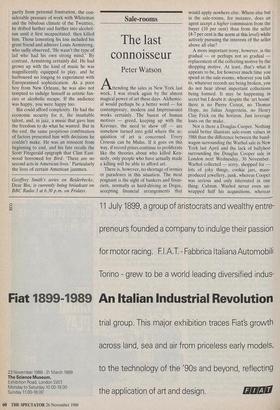Sale-rooms
The last connoisseur
Peter Watson
There is, however, no shortage of ironies or paradoxes in this situation. The most poignant is the sight of bankers and finan- ciers, normally as hard-driving as Degas, accepting financial arrangements that
would apply nowhere else. Where else but in the sale-rooms, for instance, does an agent accept a higher commission from the buyer (10 per cent) than from the seller (4-7 per cent is the norm at this level) while actively pursuing the interests of the seller above all else?
A more important irony, however, is the gradual — or perhaps not so gradual replacement of the collecting motive by the shopping motive. At least, that's what it appears to be, for however much time you spend in the sale-rooms, whoever you talk to, whatever records are being broken, you do not hear about important collections being formed. It may be happening in secret but I doubt it: despite the 'art boom' there is no Pierre Crozat, no Thomas Hope, no Julius Angerstein, no Henry Clay Frick on the horizon. Just leverage louts on the make.
Nor is there a Douglas Cooper. Nothing could better illustrate sale-room values in 1988 than the difference between the band- wagon surrounding the Warhol sale in New York last April and the lack of ballyhoo surrounding the Douglas Cooper sale in London next Wednesday, 30 November. Warhol collected — sorry, shopped for lots of joky things, cookie jars, mass- produced jewellery, junk, whereas Cooper was serious and only interested in one thing: Cubism. Warhol never even un- wrapped half his acquisitions, whereas
Cooper was given a lot of his by the artists themselves, who helped to decorate his home; Warhol hardly ever spoke about anything let alone the objects he didn't know he had, whereas Cooper was a first-rate critic; Warhol was a clever, dedi- cated follower of fashion whereas Cooper was a discreet leader of taste, helping to create an understanding of Cubism. These differences show how badly the word `provenance' has been debased in recent years. There was a time when collectors were celebrities in their own right; now celebrities like Elton John seek to conse- crate their achievement by becoming 'col- lectors'. Provenance has come to mean simply 'owned by', 'possessed by' or, even better, 'bought by'.
But collecting is not shopping and a collection is not a mere agglomeration of objects with no rhyme or reason other than that they are very expensive and have recently been on a world tour. Provenance is not a list of invoices. Proper collectors, like Cooper and unlike Warhol or Elton John, collect in a direction, with an aim; they love and understand a particular branch of art and seek to explore its aims and strengths. Anyone who remembers the Essential Cubism exhibition at the Tate Gallery a few years ago, put together by Cooper, will understand that collecting, and exhibition-forming, is an art in itself. The collection, no less than the exhibition, is an attempt to create something that the work of no single artist could achieve.
Cooper, who died in 1984 aged 73, was a wealthy Australian, a homosexual who felt uneasy in Britain and settled in the south of France. There he was friendly with several major artists and his castle in Argilliers included three rooms devoted to Picasso and one each to Braque, Leger and Gris. Other rooms were filled with the works of Klee, Miro, Cocteau etc, all of whom he knew. He had decided early on to devote a third of his considerable fortune to creating a definitive collection of Cubist artists. The 127 lots in the Cooper collection being sold this week show far he succeeded, even though they do not include his more important paintings, which are being kept Intact in his castle. But they do include at least 22 sculptures, etchings, linocuts and drawings given directly to Cooper by the artists themselves.
Three things stand out. One is the high quality of the objects — here are Picasso, Braque, Leger and de Stael especially at the top of their form. Second, the origin of many objects is interesting, reflecting Cooper's status — etchings by Picasso to protest against Franco's coup d'etat, Bra- que's unusual attempts at non-abstract figure painting, Braque prints which were lost and then rediscovered, a Leger sculp- ture of a flower, given to Cooper as a house-warming present. And third, many of the objects are not expensive. Not really expensive anyway: three or four figures, rather than eight. For all these reasons the Cooper sale is refreshing after the relentless hype of Manhattan, where the latest magazine is called Fame and where Christie's overflow room is now housed in Rdgine's, the night club in the next building. (How long before the overflow room overtakes the auction room proper in popularity? How long before .Regine herself is wielding the gavel?) We shall have our share of bally- hoo on Monday and Tuesday when we may well see a record price for a 20th-century picture. Insofar as that record, if it hap- pens, will be set by Picasso, Douglas Cooper would have been pleased. Pleased, but not taken in. Cooper, who had a sharp tongue, knew better than anyone that an obsession with high-flying prices is most prevalent in pedestrian minds.











































































 Previous page
Previous page